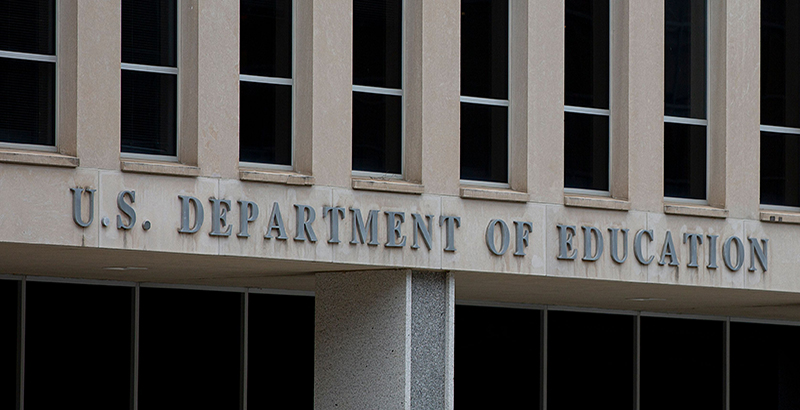This Week in Education Policy & Priorities: Feds Outline How States Can Use Relief Funds, New Report Tracks Pandemic’s Toll on Underserved Students & More

This update on the Every Student Succeeds Act and the education plans now being implemented by states and school districts is produced in partnership with ESSA Essentials, an ongoing series from the Collaborative for Student Success. It’s an offshoot of their ESSA Advance newsletter, which you can sign up for here! (See our recent ESSA updates from previous weeks right here.)
A 53-page report released by the Education Department this month seeks to identify and describe the hardships facing students during the pandemic. The report focuses on English learners, students with disabilities, students of color, LGBTQ-identifying students, and female students. It reveals that many faced additional obstacles to academic and health access and opportunities over the last year and a half.
Calling the disparities a “cause for great concern,” the report includes guidance for school systems in preventing budget cuts that disproportionately impact student subgroups and builds on additional proposals by the Biden administration at equitably closing funding gaps between districts and identifying and addressing disparities in school discipline.
Four other key federal education updates this week:
1 Ed Department Details Limits, Flexibilities of Federal Relief Funds
Updated federal guidance has been provided to schools on the use of federal relief funds passed since March 2020, a total amount that exceeds $200 billion. The guidance clarifies expected timelines and how states are expected to distribute funds to schools, while also specifying how the investments could be used to support specific student subgroups, including students with disabilities, preschoolers and high school seniors.
Though federal officials urge schools and states to guide the funding toward recovering lost instructional time, ensuring digital access, and making critical infrastructure investments, an explainer by FutureEd shows that schools will have broad flexibility in how they spend the money. According to the Edunomics Lab at Georgetown University, most available district plans lack a focus on learning recovery and many are leading with one-time investments like reward payments for teachers, staffing, and filling expected budget gaps.
2 Let’s Celebrate Schools Reopening—Then Get To Work Making Them Stronger
“As in-person learning resumes, it’s worth taking stock of the potential impact that extended school closures have had on students,” says Jim Cowen, director of the Collaborative For Student Success, in a new Forbes.com column. “There is real risk that for many of these students the impact of COVID-19 won’t be a temporary setback in their education, but a significant moment that will be immensely difficult to overcome,” he adds.
To proactively meet the needs of these students on a systemic level, Cowen urges states and school leaders to consider four broad values and actions throughout pandemic recovery: transparency, collecting actionable data from student assessments and other sources, uplifting research-backed tactics, and embracing high quality instructional materials.
Cowen additionally calls out great examples of states leading in these areas, including a model public engagement strategy employed by Alaskan education officials, firm commitments to collecting assessment data in Arkansas and Indiana, a comprehensive recovery and literacy plan in Tennessee, and the adoption of higher quality learning materials in Nebraska and Delaware. He encourages other states and districts to follow these examples. “It’s time to re-imagine, innovate, and plan so that all students leave high school prepared for college and career,” Cowen concludes.
3 Teacher’s View: How the Science of Reading Helped Me Make the Most of Limited Time With My Students
Prior to the COVID-19 pandemic, literacy was swiftly emerging as a top education priority for much of the nation, as data showed only one-third of U.S. students reading proficient at grade level — largely due to fractured and disparate approaches to reading instruction and schools’ slow adoption of the “science of reading.” Jessica Pasik, a reading specialist and professor of literacy in New York, says the stress of COVID-19 has only exacerbated these challenges.
In a new essay, Pasik details how tenants of the science of reading actually helped her engage students and take advantage of limited instructional time during a year of virtual learning. Some educators in Texas’ San Antonio ISD are similarly sharing that such an approach helped them structure learning much more effectively during the pandemic and to drive improvements in student progress. They are urging fellow teachers to shift from the “balanced literacy” approach that has been declining in favor in recent years. “People, I believe,” one teacher stated, ”will move into what’s best for our students.”
4 Present Danger: Solving the Deepening Student Absenteeism Crisis
A new report from the team at FutureEd warns of a growing crisis of student absenteeism, based on analysis of five large school districts serving nearly half a million students. The report states that absenteeism may have been greater during the pandemic than previously thought. “Not only are more students missing school, they’re missing many more days than in the past,” the report warns.
Additionally, the report flags that absenteeism is rising fastest for the youngest learners, while trends for disadvantaged students were exacerbated by the pandemic in all districts reviewed. The report is echoed by coverage from Governing magazine, which similarly depicts significant increases in chronic absenteeism and states that data should be used by district and state leaders to identify missing students and reconnect them to school systems.
Get stories like these delivered straight to your inbox. Sign up for The 74 Newsletter

;)